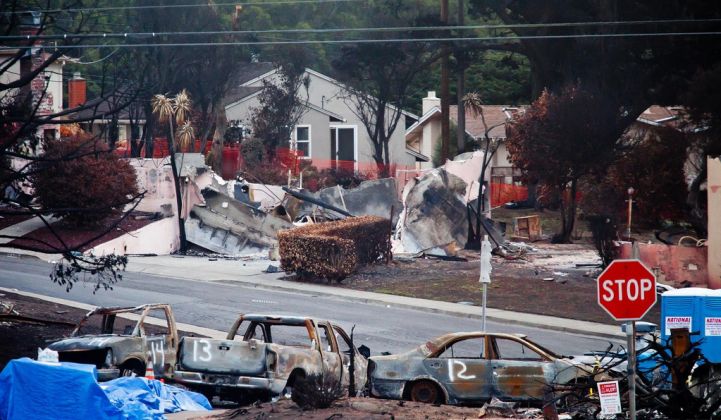Now PG&E is taking the effort on the road with the help of Picarro. On Monday, the startup demonstrated two Chevy Volts carrying its Wavelength-Scanned Cavity Ring Down Spectroscopy instruments. The sensors use lasers and mirrors to detect miniscule amounts of specific gases in the atmosphere, at sensitivities about 1,000 times greater than traditional instruments, Picarro says.
PG&E demonstrated two sensor-mounted Volt hybrids at Picarro’s Santa Clara, Calif. headquarters on Monday, and said it was planning to put more on the road if it can prove the technology works. Nick Stavropoulos, PG&E’s pipeline safety czar, told reporters Monday that the utility would like to see them checking 50,000 miles of the company’s sprawling gas pipeline network.
PG&E has already invested $366 million into pipeline safety under an August 2011 plan that calls for $2.2 billion in spending. While the lion’s share of that will go toward new pipes and other hard infrastructure, mobile solutions could be a lot more cost-effective than trying to monitor every part of the largely unsensored natural gas grid.
Picarro was founded in 1998 and has raised a total of $48 million in venture capital investment, with investors including Benchmark Capital, Greylock Partners, SkyMoon Ventures, Staenberg Venture Partners and Weston Presidio Capital. Picarro CEO Mike Woelktold the Silicon Valley Business Journal in 2010 that the company was breaking even financially, and on Monday said that Picarro was profitable and selling equipment globally.
Woelk, who joined Picarro in 2007, has written at Greentech Media about its carbon dioxide monitoring solution, part of the wholesale shift he led the company on, away from industrial and chemical plant applications and toward environmental applications.
“It was a huge risk,” Woelk said during Monday’s press conference. “But it was something we wanted to do, something we felt compelled to do.” Of course, “the timing could have been better,” he noted, with the 2008 recession stalling its growth rate.
Stavropoulos said that it taken some persuading on Picarro’s part to convince PG&E of the viability of their technology. He certainly sounded convinced on Monday, though, calling the technology “revolutionary. It is unlike anything that exists in the world today.”
Unlike today's detection equipment, Picarro's can work while its driving down the road, he noted. It uses GPS to take second-by-second snapshots of gases detected within up to one meter accuracy, then calculates for wind speed to zero in on the source, he said. The system also communicates with work crews to give them real-time updates on where the leak is, and is managed on Picarro’s cloud-based processing platform, he said.
Woelk compared the one-in-a-billion sensitivity of Picarro’s equipment to a computer that “knowing every second the birth rate or the death rate in the entire population of the world -- not estimating it, knowing it.” Of course, PG&E is making a bet that the technology will work in the field under everyday strains and stresses.
It’s also hoping that Picarro’s technology can clarify fake or unimportant leaks from dangerous ones. “The overwhelming majority of leaks pose absolutely no safety hazard,” Stavropoulos noted. “We’re trying to identify those we need to get crews to right away.”
Going mobile could squeeze into a couple of years the work PG&E now has to schedule on five-year periods, while increasing the frequency and sensitivity of gas leak detection, Stavropoulos said. That’s going to help the utility in its quest to prove to state and federal regulators that it’s living up to its gas pipeline promises.
PG&E and Picarro didn’t say how much the car-mounted scanning vehicles cost, and Woelk more or less dodged the question on Monday. “When you look at what it can do, there’s nothing to compare it to” in terms of miles covered and speed of deployment, he said.
As for how much per-vehicle a 25-volt deployment might cost, “Those are some of the things we’re working on,” Woelk said. “Our business model is moving from a capital equipment to a service model.”
On PG&E’s side, Stavropoulos said the utility could have the cars fully deployed within PG&E’s current cost structure for pipeline safety, while increasing safety and reducing methane emissions -- in an “emissions-free” car as well.
Woelk also pointed out that gas utilities can move faster than most industry observers might expect. Indeed, natural gas is emerging as a new smart grid front, with big utilities like Southern California Edison deploying smart gas meters.
U.S. Rep Mike Honda (D-Campbell) took the podium Monday to boost the Picarro-PG&E project as a major advancement not just for safety, but for pollution and carbon management as well.
While the U.S. isn’t a good market for carbon monitoring businesses, Picarro does about 30 percent of its business in Europe and another 30 percent in Asia, Woelk said Monday. Indeed, Picarro demonstrated its greenhouse gas-sniffing capabilities at the Davos World Economic Forum in Switzerland last week.



